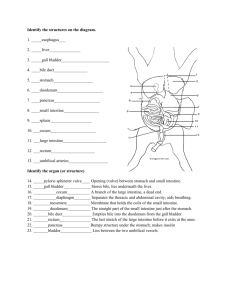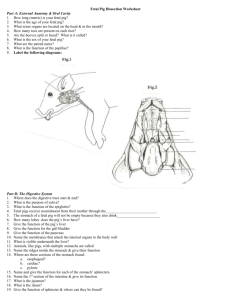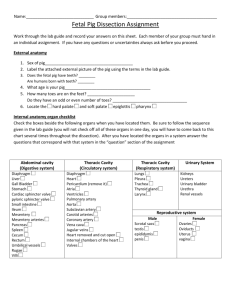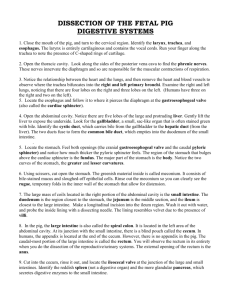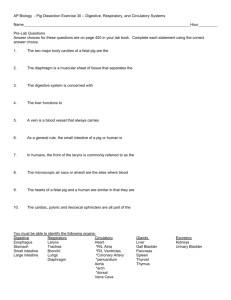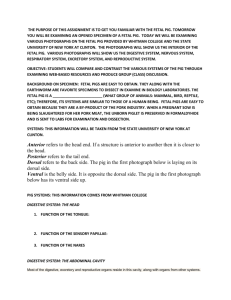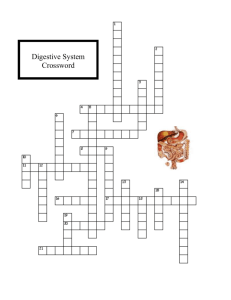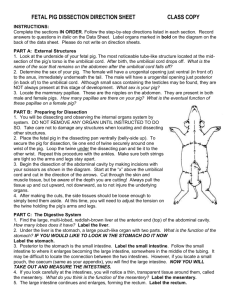Notes from May 27 - Anatomy for Demos
advertisement
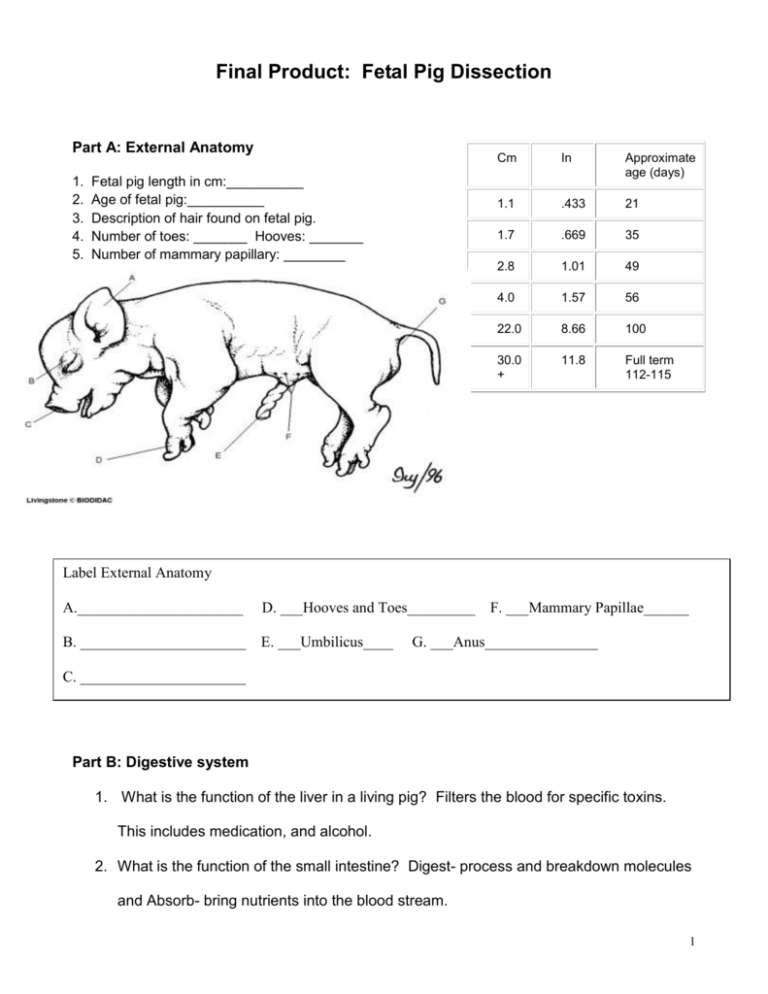
Final Product: Fetal Pig Dissection Part A: External Anatomy 1. 2. 3. 4. 5. Fetal pig length in cm:__________ Age of fetal pig:__________ Description of hair found on fetal pig. Number of toes: _______ Hooves: _______ Number of mammary papillary: ________ Cm In Approximate age (days) 1.1 .433 21 1.7 .669 35 2.8 1.01 49 4.0 1.57 56 22.0 8.66 100 30.0 + 11.8 Full term 112-115 Label External Anatomy A.______________________ D. ___Hooves and Toes_________ B. ______________________ E. ___Umbilicus____ F. ___Mammary Papillae______ G. ___Anus_______________ C. ______________________ Part B: Digestive system 1. What is the function of the liver in a living pig? Filters the blood for specific toxins. This includes medication, and alcohol. 2. What is the function of the small intestine? Digest- process and breakdown molecules and Absorb- bring nutrients into the blood stream. 1 3. What specific macromolecule(s) is bile used to break down during digestion? Lipase is made in the gall bladder and is imported into sm. Intestine to break down. 4. What is the importance of the mesentery? Hold and shape the intestines 5. Length in cm of the small intestine: ______ 6. Large intestine length in cm: _______ A. ______Liver___________ B. ____Sphincter to Stomach_ C. _stomach______________________ D. Spleen?_______________________ E. Large intestine_______________________ F. __colon?_____________________ G. Anus or rectum_______________________ H. mesentary_______________________ I. duodenum_______________________ J. small intestine_______________________ K. ??_______________________ L. Pyloric valve_______________________ M. _______________________ N. _______________________ O. _______________________ P. ____Liver____________ Digestive System: Product 2 1. Create a drawing, tracing, or photograph and identify each of the following in the picture: esophagus, stomach, small intestine, large intestine, liver, mesentery, pancreas, gall bladder, spleen, rectum, anus 2. Answer each of the following by writing complete sentences that include the question asked as a part of the answer. **Saliva contains water (to moisten food), mucus (to lubricate food), salivary amylase (to break down starch), bicarbonate (to buffer acids in food), and antibacterial agents. Why might these last three components be necessary when the stomach is the next destination anyway? A. Would you expect carnivores to have longer or shorter intestines than herbivores? B. What happens if the contents of the colon pass too rapidly through the colon? too slowly? 3. Complete the following chart identifying the role each of these features and organs play (copy this chart into your log book or presentation) Body part or organ Role Why is this important? Salivary Glands Tongue Stomach Small Intestine Large Intestine Mesentery Liver Pancreas Gall Bladder 3 Part C: Respiratory system 1. What is the function of the diaphragm in a living pig? Expands to allow breathing in and out Label Respiratory System A.larynx______________________ B. __glands____________________ C. trachea______________________ D. _bronchial tubes_____________________ E. _lungs_____________________ F.diaphram _diaphram_____________________ Respiratory System: Product 1. Identify each of the following in a drawing, tracing, or picture: larynx, trachea, bronchi, diaphragm, lungs 2. Why does the trachea have cartilaginous rings? 3. Why is it important for air to be moist when it enters the lungs? Many desert mammals have extremely convoluted nasal cavities. How might these large and complex nasal cavities conserve water during exhalation? 4. A human pregnancy is typically 40 weeks in length. During human fetal development, the fetus does not start to produce pulmonary surfactants until about the 34th week of development. Use your understanding of lungs and pulmonary surfactants to describe one health concern for babies born prematurely (before the 34th week of development). 4 Part D: Circulatory system 1. Which ventricle of the heart has more cardiac muscle? Explain your answer. 2. Label parts of the heart. A. _____________________ B. _____________________ C.______________________ D.______________________ E.______________________ F.______________________ G.______________________ H.______________________ I._______________________ Figure 4, Heart Circulatory System Product: Describe the flow of blood through the body, starting with the right ventricle and ending with the right atrium. 5 Part F: Urogenital system 1. Label Male Pig A.______________________ B. ______________________ C. ______________________ D. ______________________ E. ______________________ 2. Label the Female Pig A.______________________ B. ______________________ C. ______________________ D. ______________________ E. ______________________ 6 Urogenital System Product: 1. Describe the function of the kidney. 2. What is dialysis and why is it required for a person whose kidneys have failed? 3. Why do most male mammals have testes in an external sac (scrotum)? (Hint: there is some evidence that men that who wear briefs produce fewer viable sperm than men that wear boxers). 4. Cat uterus Cats, dogs, and rabbits have long, wide horns of the uterus. Humans and pigs have long fallopian tubes, short horns on the uterus, and one wider, single uterus. Why is there a difference between these mammals? What might be the advantages of each type of uterus? 7
